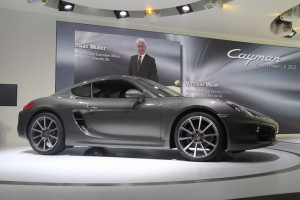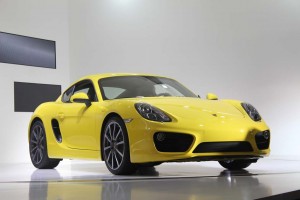Porsche intends to extend its winning strike as it launches an all-new update of its smallest sports coupe, the Cayman, which made its first public appearance during a well-attended debut at the LA Auto Show.
Like the similarly sized Boxster roadster, the 2013 Porsche Cayman is lighter and sleeker, with a longer wheelbase and wider track designed to enhance both its visual appearance and its road manners. Porsche engineers also have pulled off the seemingly impossible, as they did with several other recent models, not only boosting performance but squeezing out significantly better mileage.
“The new version is lighter, more powerful and more fuel-efficient than ever,” said Matthias Mueller, CEO of the Stuttgart-based maker – which effectively became part of the growing Volkswagen AG empire this year.
The Cayman, the sibling of the Boxster – which itself was completely updated earlier in 2012 – will reach U.S. showrooms in April of next year. Both models are produced at Porsche’s plant in Zuffenhausen, Germany, though the maker has the option of adding a second line elsewhere if demand is strong enough.
Though the basic look is familiar, the actual dimensions of the 2013 Porsche Cayman are revised slightly – though enough to impact its driving behavior. It gains 1.4 inch in overall length, a modest stretch in wheelbase and a bit wider track – 1.4 inches in front and 0.2 inches in the rear. It is also about 0.4 inches lower.
The underlying, aluminum-intensive chassis is the same as is used in the open-top Porsche Boxster.
The interior of the 2-seater, meanwhile, has been significantly revised to improve on what was a rather cramped cockpit in earlier versions. The cabin has also been upgraded to give it a more luxurious look and feel.
Two versions will be offered, as in the past. The “base” Cayman will feature a 2.7-liter engine that replaces the prior-generation’s 2.9-liter package. Nonetheless, it makes 275 horsepower, a boost of 10, and 214 lb-ft of torque. That’s enough for a 5.7-second launch from 0 to 100 kmh (0 to 62.5 mph), Porsche says, with a 165 mph top speed.
The up-market Cayman S features a 3.4-liter package that gains 4 hp for 2013, at 325 horsepower and 273 lb-ft of torque. It will make the run to 100 kmh in as little as 4.7 seconds with the new 7-speed manual gearbox – which is shared with the top-line Porsche 911. Equipped with the alternate 6-speed PDK dual-clutch transmission, that stretches to 5.0 seconds. The choice of transmissions is also offered on the lower-priced Porsche Cayman.
It will come in at $52,600, Porsche revealed, plug $950 for destination charges, the 2013 Porsche Cayman S starting at $63,800. However, the maker has traditionally offered a wide buffet of options that routinely add thousands of dollars to the average purchase price.
There are some other numbers that could impress buyers – even those who can afford to cope with rising fuel prices but still appreciate a more efficient, environmentally friendly design. Depending on the gearbox, the 2013 Porsche Cayman is expected to get a highway rating of as much as 32 mpg, according to Porsche, with the Cayman S yielding as much as 30 mpg.
Of course, performance is at the heart of any Porsche model and the German maker contends the new models should be both faster and more nimble due to the added power, reduced weight and lower center of gravity.
The 2013 Porsche Cayman and Cayman S adopt an electro-mechanical steering system similar to what was introduced on the latest Porsche 911 last year. It also will be available with a new Porsche Active Suspension Management system that can adjust throttle, steering and suspension settings.
The launch of two new models, the 911 and Boxster, this past year helped the maker achieve a record-setting global sales increase of 15% during the first 10 months of 2012, noted CEO Mueller, and offered, “the best possible proof” that even at a time when fuel prices dominate headlines, demand for sports cars remains strong.
The LA Auto Show launch came just a day after Porsche broke ground in Atlanta for a new U.S. headquarters complex to feature, among other things, a new training center and high-performance track.


